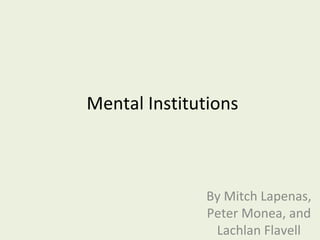
English mental institutions
- 1. Mental Institutions By Mitch Lapenas, Peter Monea, and Lachlan Flavell
- 3. Electroconvulsive Therapy Electroconvulsive therapy or electroshock, is a controversial, psychiatric treatment in which seizures are electrically induced for therapeutic effect. Today, ECT is most often used as a treatment for severe depression which has not responded to other treatment, and is also used in the treatment of mania (bipolar disorder), and catatonia. It was first introduced in the 1930s and gained widespread use as a form of treatment in the 1940s and 1950s; today, an estimated 1 million people worldwide receive ECT every year, usually in a course of 6–12 treatments administered two or three times a week. It is not used in Australia as it is known to cause more pain than it will cure.
- 4. Medication Some medication was prescribed to mental patients, and often these drugs were the eventual cause of their death. Some of the substances were used to kill off parts of the brain, usually the front lobes, and it has been known to work very effectively. Anxiolytics were used, generally used for these procedures and are now used in smaller doses for anxiousness and sleeping disorders. Mood stabilizers are still used primarily in bipolar disorder, mainly targeting depression and Antipsychotics are used for psychotic disorders, notably in schizophrenia and psychosis. Stimulants are commonly used, notably for ADHD.
- 5. Lobotomy The Lobotomy was first carried out on a live patient in 1946, all previous attempts on live patients were complete failures and all of the patients died shortly after the procedure. It involved sending a medical tool known as Orbitoclasts into the eye sockets using a small hammer and then using them to cut the tissues of the frontal lobes. This was successful and was taught to Psychiatrists in mental institutions so that they could perform them internally. An interesting fact that when a sedative took too long, they would use electroconvulsive therapy to sedate the patient. This procedure left them unable to think for themselves, and often referred to as the ‘human vegetable’.